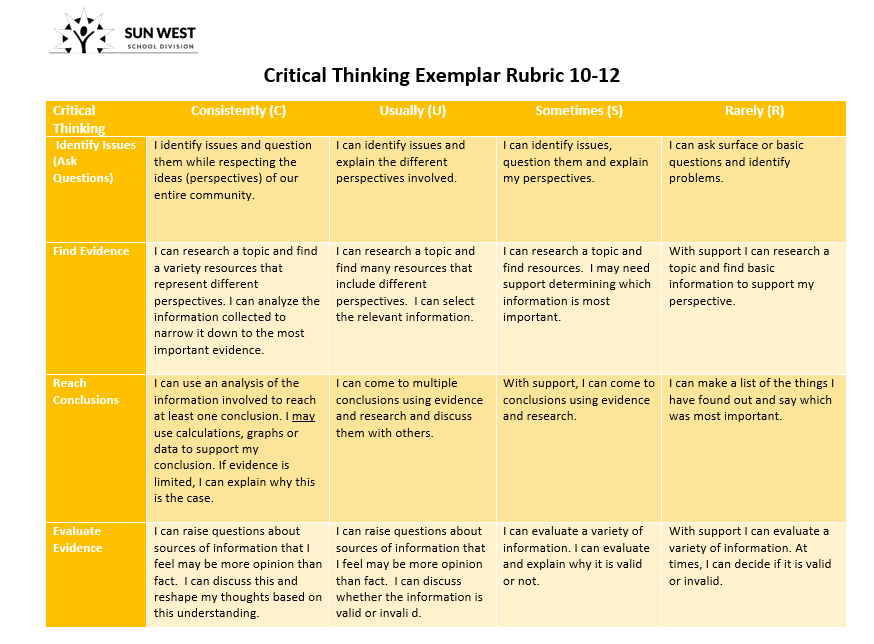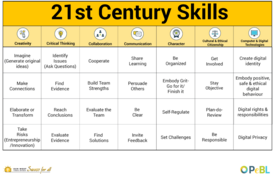Critical Thinking Guidebook - 10-12 (High School) Sun West
Critical Thinking High School 10-12
Purpose
Why is this important?
Critical thinking is a key 21st Century skill that students need to embody in order to successfully ask questions before seeking and evaluating answers in order to reach creative solutions. Having the skills and abilities to identify issues, find evidence, reach conclusions, and evaluate evidence, allows students to be successful participants in the planning of their learning and assessment.
Key Steps in Teaching Critical Thinking Strategies
1. Isolate the skill needed to be taught.
2. Provide students with direct teaching to learn strategies and practice self-awareness.
3. Provide and allow opportunities for students to practice the skills and strategies, and reflect often. This takes time at first, but students are rewarded for their efforts once they are able to master their practised skill.
4. Revisit strategies and skills often.
Explicit Teaching
To be able to learn and grow in 21st Century Competency understanding, it is important to teach each skill and let students experience what each skill looks like as well as how you can grow in each area. Caution: by simply saying the word "communication or collaboration...etc" students may not get a full understanding of each skill. Explicitly teaching and utilizing skills in different ways is what will ultimately promote deep understanding and growth in 21st Century Competencies.
Timeline Suggestions for Explicit Teaching
The document below provides a year plan to teach each of the 21st century skills. It is beneficial to have an explicit teaching plan to ensure each skill is taught; however skills should also be reinforced as much as possible throughout class time.
Lesson Plan Ideas
Identify Issues (ask questions)
Critical Thinking: The powerpoint will provide strategies and to add skills to our toolkits that can be used to help engage our students in the use of 21CC skills- one of the focuses this year is Critical Thinking
Critical Thinking Resource: provides a video about critical thinking (about 7 min)
Find Evidence
Supporting Critical Thinking: Materials to activate critical thinking as a reading strategy in the classroom
The Ultimate Cheatsheet for Critical Thinking: Ask these questions whenever you discover or discuss new information.
Reach Conclusions
How do we Teach Students to Identify Fake News?: students learn to approach news and information with a critical eye in order to identify intentionally misleading sources (although recent studies confirm that this is an uphill battle for both adults and young people).
Evaluate Evidence
Using Critical Thinking to Find Trustworthy Websites: students evaluate online sources using guided questions and a rubric as they explore the idea of year-round schooling
Reflecting: Reflecting is a process whereby students use critical thinking skills to look back on their learning experience in terms of things that went well and areas where there may be room for growth/change.
Integration of Skills
Intentional integration of 21st Century Competency language in all day-to-day activities supports the development of routine reflection, skill use, and growth in support of curricular knowledge acquisition.
Why?
If we do not intentionally integrate 21st Century Competency connections into our learning environments, it is easy to forget about them. As the language becomes routine, growth in skills can and should be explored regularly. Ultimately the 21st Century Competencies are the skills needed to be successful in all day-to-day activities as well as future career opportunities. By being intentional in integrating the language and skill use in all aspects of learning, understanding of the skills can be applied and reflected upon to look for areas of potential growth and application.
How?
Once skills have been explicitly taught, integration of 21st Century Competencies can be achieved by connecting skills to all curricular areas, participating in pre-and post reflections (allowing students to predict which skills will be needed and subsequently which skills need to be worked on) and the use of 21st Century Competency rubrics to track growth. Example: by using learner profile data, students can reflect on which skills they need to employ for a particular activity and based on this information, choose group members that have strengths or challenges in those skill areas.
Examples
When integrating 21 Century Competency language in all areas of learning consider the following curricular connected resources. As you use similar resources in your own learning environment, how can you relate them back to growth and understanding of the 21 Century Competencies?
In ELA
ELA 10: Critical Thinking: students pitch a documentary to a big-time Executive Director, and convince him/her that this film is worth the money.
ELA 20: On Golden, Pond Critical Thinking: Topics are mildly controversial and therefore tend to be higher interest to grade 11 students
ELA 20: Words of Wisdom: This three-part assignment was one that covered two outcomes; Outcome: CR 20.2, as well as Outcome: CC 20.1.
ELA 20: To Kill a Mockingbird Civil Rights: For this assignment, students were asked a series of open-ended questions relating to the Civil Rights Movement
ELA B30: Assess and Reflect Activities: designed to help students set goals that they wish to work towards in ELA B30 and have them measure how well they are achieving those goals.
Draft Letters: Improving Students Writing Through Critical Thinking: designed to help students set goals that they wish to work towards in ELA B30 and have them measure how well they are achieving those goals.
In Math
Exploration Critical Numbers and Max/Min Values: Students are grouped together to explore the relationship between the vertex of quadratic functions that they have learned in previous math courses with derivatives and critical numbers in Calculus
Work Place and Apprenticeship: In this lesson, the students will be developing an idea for a possible small business that they would like to start and run.
Connect the Dots- Math Game: Directions for this age-old strategy game that gets your students thinking creatively and critically
Teachable moments
Whenever a question, situation, comment or activity that involves a connection to a 21 Century Competency arises, take a moment to talk to students about it. Discussing skills, how they integrate into everything you do in life makes the reflection on the importance of skills a habit. This habit will instil a growth mindset around developing skills to their fullest potential. Teachable moments can be as short as 20 seconds. Make it your habit and it will become theirs!
Tracking Growth
When considering 21st Century Competency application, it is essential for both the teacher and the student to track growth. There is clear potential for growth in skill use throughout our lives. To ensure growth and understanding of application is taking place, we can easily track progression using rubrics, checklists, and self-assessments.
Formative Assessment
Formative assessments of 21st Century Competencies include anecdotal documentation, self-assessments and rubric check-ins. These formative assessments provide snapshots of growth throughout the learning process and allow goal setting to take place.
See below for Self-Reflection and Goal Setting Documents:
Assessing Growth
Summative Assessment
Exemplar Rubrics

Critical Thinking 10-12
Critical Thinking Exemplar Rubric 10-12
|
Critical Thinking |
1 | 2 | 3 | 4 | 5 |
|
Identify Issues (Ask Questions) |
I can ask surface or basic questions and identify problems | I can identify issues and explain my perspectives | I can identify issues, question them and explain my perspectives. | I can identify issues, question them and explain the different perspectives involved. | I understand the issues and can make a plan that will respect the ideas (perspectives) of our entire community. |
|
Find Evidence |
I can find basic information | With support I can research my perspectives and find many different related resources. | I can research my perspectives and find many different related resources. | I can research my perspectives and find many different related resources and debate my findings with others. | I can research my perspectives and find many different related resources and debate my findings with others to narrow them down to those most important. |
|
Reach Conclusions |
I can make a list of the things I have found out and say which was most important. | With support, my conclusion uses evidence and research to answer all my questions. | I can come to conclusions using evidence and research. | I can come to multiple conclusions using evidence and research and discuss them with others. | My conclusion contains analysis of the information. I may use math, graphs or data to show this. If the evidence is limited, I can explain this. |
|
Evaluate Evidence |
I can choose which information to evaluate and decide if it is applicable. | I can choose which information to evaluate. With support I can evaluate a variety of information. I can evaluate and explain why it is valid or not. | I can evaluate a variety of information. I can evaluate and explain why it is valid or not. | I can raise questions about sources of information that I feel may be more opinion than fact. I can discuss whether the information is true or untrue. | I can raise questions about sources of information that I feel may be more opinion than fact. I can discuss this and reshape my thoughts. |
Co-creating Rubrics
Resources
Sun West Resource Bank Critical Thinking Resources
Print based
The Ultimate Cheatsheet for Critical Thinking Poster
Art 9 Critical Thinking Symbols and Totem Poles
Inquiry: Using an Egg Drop Activity to Promote Critical Thinking and Analysis
The Critical Thinking Workbook
Videos
Critical Thinking Resource from UBC: This resource provides a video about critical thinking (about 7 min). Students can then apply what they learn, visualize it and explore more links about it.
Using Debate to Develop to Develop Critical Thinking and Speaking Skills: In this video, students debate the potential privatization of social security. Debates begin with a five-minute introduction by the pro- and anti-debaters.
Student Toolkits from UBC:(Note taking, Critical Thinking, Presentations, Study Skills, Writing, Working in Groups) 21st Century Skills
Interactive
10 Great Critical Thinking Activities That Engage Your Students: here are some amazing critical thinking activities that you can do with your students.
10 Team-Building Games That Promote Critical Thinking: Lots of great and interactive games to develop critical thinking.
Educational Articles
The Importance of Teaching Critical Thinking: Critical thinking is a term that is given much discussion without much action
Websites
Visible Thinking: Visible Thinking is a flexible and systematic research-based approach to integrating the development of students' thinking with content learning across subject matters.
Using Critical Thinking to Find Trustworthy Websites: In an effort to learn more about the accuracy and reliability of websites, Emily Koch's middle school students evaluate online sources using guided questions and a rubric as they explore the idea of year-round schooling.
Write-Around Discussion: This strategy provides students with an opportunity to either activate prior knowledge on a topic or consolidate recently-learned information.
Critical Thinking: learn and share ways to help students go deeper with their thinking.
